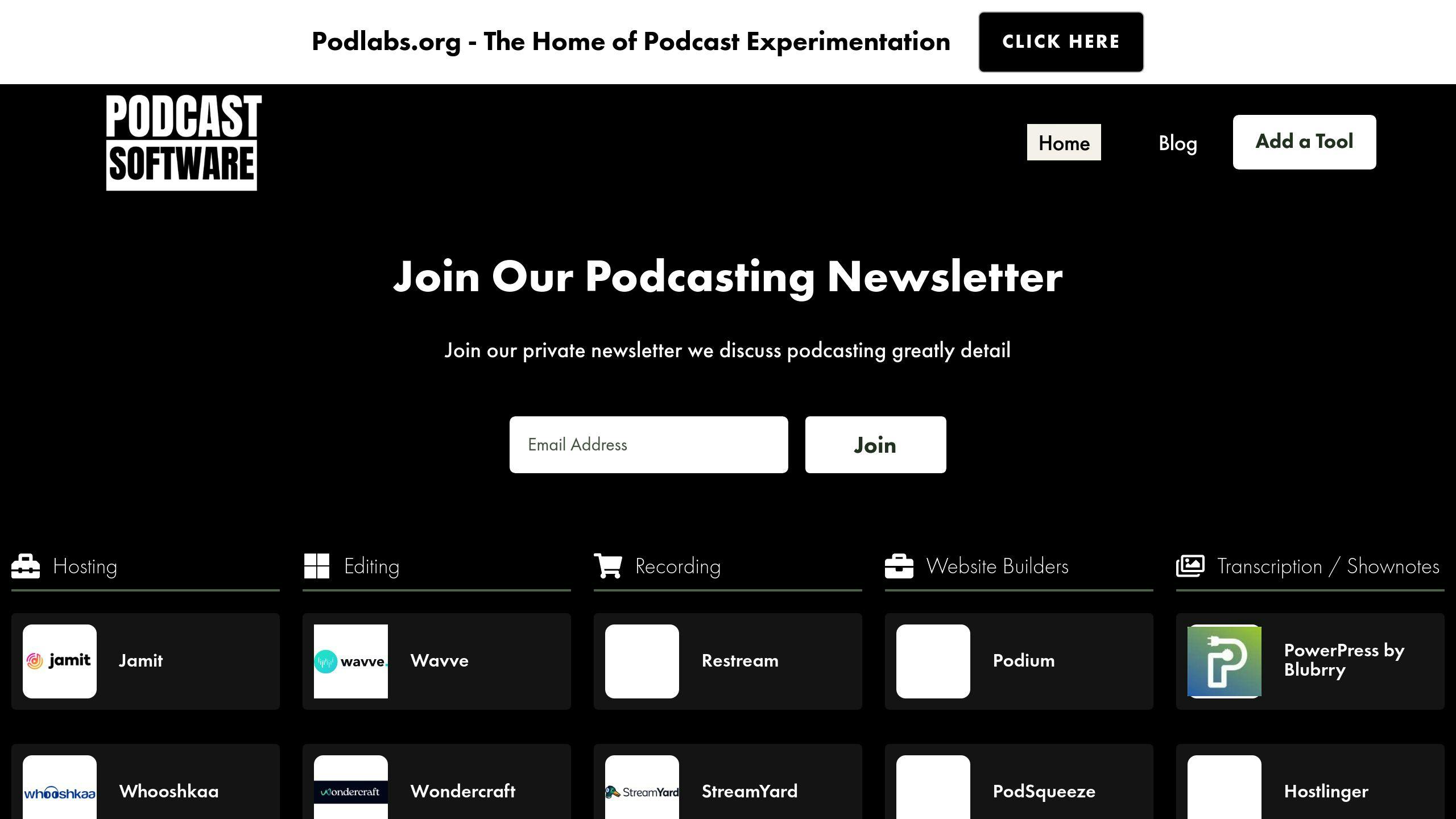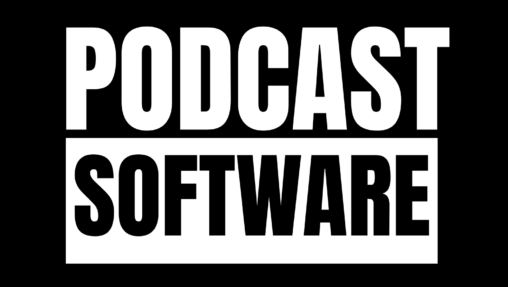Podcast publishing can be time-consuming, but automation makes it faster and easier. Here’s how you can simplify the process:
- File Uploads: Automate transfers using tools like Google Drive and Make.com.
- Transcription: Use OpenAI Whisper for accurate audio-to-text conversion.
- Content Creation: Generate titles, show notes, and descriptions with ChatGPT.
- Publishing & Scheduling: Automatically release episodes on platforms like Spotify and Apple Podcasts.
- Social Media Promotion: Share episodes across platforms with tools like Nuelink.
- Notifications: Stay updated on workflow progress via automated alerts.
With these tools, you can save 9–12 hours weekly while focusing on creating great content.
Tools for Podcast Automation
Podcastsoftware.co

Podcastsoftware.co is your go-to resource for finding tools to streamline podcast workflows. From hosting platforms to editing software and podcast players, it offers a curated list to help you choose the best options.
Once you’ve picked the tools that fit your needs, platforms like make.com can help you connect and automate them effortlessly.
make.com for Workflow Automation
make.com is a versatile platform designed to automate and connect your podcasting tools. Here’s how it can simplify your workflow:
| Feature | What It Does | How It Helps |
|---|---|---|
| File Transfer Integration | Automatically uploads files from cloud storage to your hosting platform | Saves time by removing manual steps |
| Trigger-based Workflows | Executes tasks based on specific actions or events | Keeps your publishing schedule on track |
| Multi-app Connection | Links transcription services, hosting platforms, and more | Ensures all tools work together smoothly |
OpenAI Whisper and ChatGPT for Content Automation
OpenAI Whisper converts audio into text with impressive accuracy, while ChatGPT takes that text and creates titles, show notes, and platform-specific descriptions. Together, they simplify content creation [1].
By linking AI tools like Whisper and ChatGPT with platforms like make.com, you can automate everything from transcription to content distribution [1][2].
"The use of AI tools like OpenAI Whisper and ChatGPT can significantly streamline the podcast publishing process by automating transcription and content creation" [1].
Related video from YouTube
Guide to Automating Podcast Publishing
Streamlining your podcast publishing process with automation can save time and ensure consistency. Here’s how you can automate key steps in your workflow.
1. Automate File Uploads
Create a dedicated folder in Google Drive for your podcast episodes. When you upload a new file, tools like make.com can trigger automated workflows. These workflows handle tasks like checking the file format and initiating the next steps in your process. This setup ensures your publishing workflow starts smoothly.
| Task | Tool | Function |
|---|---|---|
| File Detection | Google Drive | Tracks new episode uploads |
| Workflow Trigger | make.com | Starts the automation sequence |
| Format Check | make.com | Verifies audio meets platform standards |
2. Automate Episode Transcriptions
Use OpenAI Whisper to automatically transcribe your podcast episodes. By integrating make.com, you can send audio files directly to OpenAI Whisper for transcription. The output can then be formatted for SEO purposes and accessibility, eliminating manual transcription work.
3. Automate Publishing and Scheduling
Connect your workflow to podcast hosting platforms using their APIs. This allows episodes to be automatically published and scheduled on platforms like Spotify, Apple Podcasts, and Anchor without manual uploads.
4. Automate Notifications
Set up notifications to keep you informed at key points in the process, such as:
- Workflow Status Updates: Alerts for file processing or transcription completion.
- Publishing Alerts: Notifications for scheduling and distribution progress.
These updates help you monitor the process without constant hands-on involvement. Configure notifications via email or your preferred messaging app to stay informed while maintaining control over quality.
sbb-itb-9f49a8d
Additional Automation Tactics
Automate Social Media Promotion
Streamline podcast promotion by setting up workflows for automatic social sharing. For example, Nuelink can distribute content from Spotify to multiple social platforms with ease, creating branded posts in the process [4].
| Task | Tool | Benefit |
|---|---|---|
| Sharing Across Platforms | Nuelink | Shares content on various social networks |
| Customizing Content | Make.com | Adapts posts to fit each platform’s format |
Once you’ve automated social media promotion, you can shift focus to other time-saving tasks, like crafting show notes.
Automate Show Notes Creation
Speed up the process of creating detailed show notes with AI tools. Text expanders can simplify the inclusion of recurring elements, such as:
- Links to your social media profiles
- Patreon details
- Episode templates
- Sponsor messages
Additionally, tools like the Zapier x Transcribe integration can save time by routing audio files from your cloud storage directly to transcription services [2].
With these systems in place, you’ll have more time to refine your recording process.
Automate Recording Setup
Simplify your recording setup by creating custom shortcuts for your equipment and software. These one-click shortcuts can launch recording programs, configure your microphone, and activate backup systems, making setup hassle-free.
To ensure reliability, always have a backup plan for essential recording components. Regularly test and update your workflows to adapt to new tools or equipment changes [3]. By automating this step, you’ll make the entire process – from recording to publishing – much smoother.
Conclusion: Simplify Your Podcast Workflow
Automating your podcast publishing can make a complicated process much more manageable. Here’s how you can start incorporating automation into your workflow.
Tools like Make.com, OpenAI Whisper, and ChatGPT can handle tasks such as file uploads, transcriptions, and scheduling, saving you both time and effort. For additional resources, Podcastsoftware.co provides detailed recommendations for hosting platforms, editing tools, and podcast players to help you choose the best options for your needs.
Here’s a breakdown of how automation can save you time:
| Automation Phase | Tools | Time Saved (Weekly) |
|---|---|---|
| Basic Setup | Make.com + Cloud Storage | 2-3 hours |
| Content Processing | OpenAI Whisper + ChatGPT | 4-5 hours |
| Distribution | Nuelink + Platform APIs | 3-4 hours |
FAQs
How do I schedule a podcast episode?
- Link your podcast hosting platform (like Spotify or Apple Podcasts) to make.com.
- Set up a Google Drive folder with triggers for new uploads.
- Configure the publishing date and time directly in your hosting platform.
This setup eliminates manual scheduling and ensures episodes go live on time [1][2].
Can I automate show notes creation?
Yes, AI tools can simplify this process. For example, OpenAI Whisper transcribes episodes, and ChatGPT extracts key points and formats them into polished notes.
| Step | Tool | Output |
|---|---|---|
| Transcription | OpenAI Whisper | Full episode text |
| Content Analysis | ChatGPT | Key points and highlights |
| Notes Generation | ChatGPT | Ready-to-use show notes |
How can I automate social media promotion?
You can connect your podcast’s RSS feed to social media scheduling platforms. This lets you automatically create and share posts when new episodes are published [3].
What tools are essential for podcast automation?
Here’s a quick breakdown of tools that can streamline your workflow:
- Workflow Automation: make.com to connect your apps and services.
- AI Transcription: OpenAI Whisper for converting audio to text.
- Content Creation: ChatGPT for crafting show notes and episode descriptions.
- Cloud Storage: Google Drive for organizing and managing files.
Using these tools can save you 9–12 hours every week [1][2].
Can the entire podcast process be automated?
Not entirely. While automation can handle repetitive tasks like file uploads, transcription, scheduling, and social media sharing, some steps still need your personal touch. Creative work, like content creation and final editing, requires human input to maintain your podcast’s unique style and quality [1]. Automation supports the process, but your creativity is what makes your podcast stand out.

